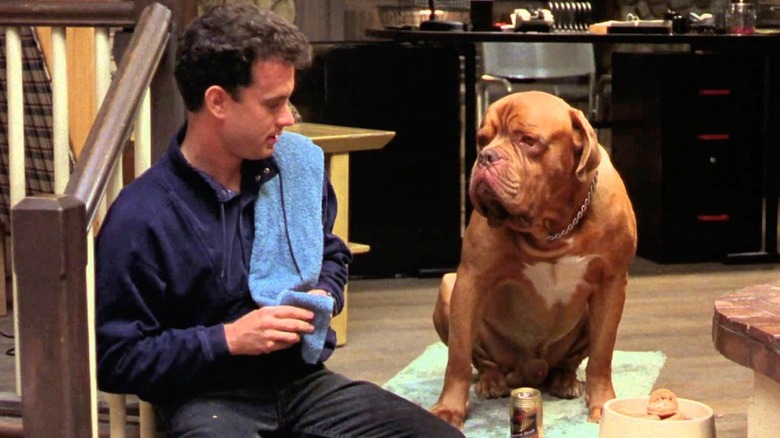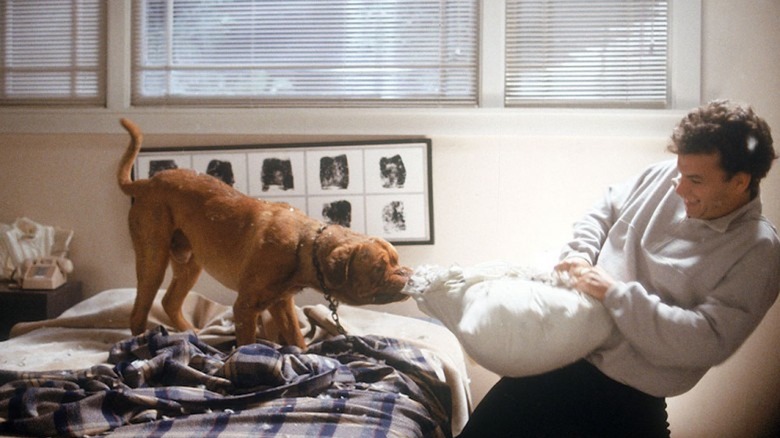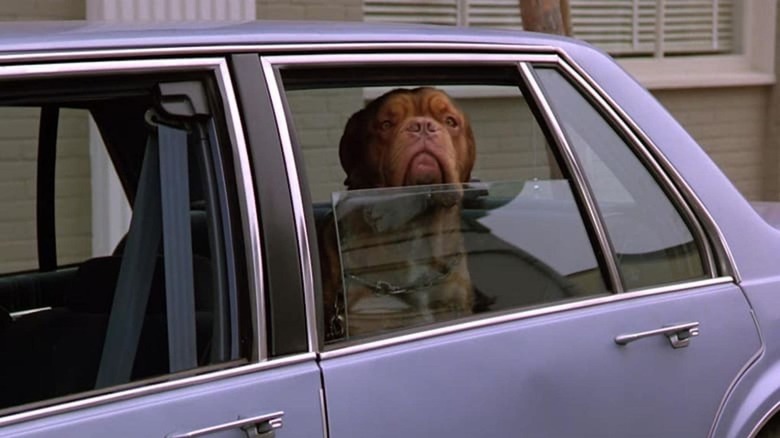Tom Hanks' Furry Co-Stars Needed Some Special Training For Turner And Hooch
Before Tom Hanks became "America's Dad," he was a young heart throb of the 1980s. Starring in hit films like "Big," "Splash," and "Bachelor Party," Hanks met his match for most lovable lead character in the 1989 comedy "Turner & Hooch."
Directed by Roger Spottiswoode (whose filmography also includes the notorious Sylvester Stallone misfire "Stop! Or My Mom Will Shoot" and the James Bond film "Tomorrow Never Dies"), the cute cop comedy was more successful than not and eventually launched a franchise composed of a failed spinoff show pilot-turned TV movie sequel — which aired as part of "The Magical World of Walt Disney" in 1990 — and a legacy sequel series that released on Disney+ in 2021. In the original film, Beasley the dog starred as the sweet and slobbery Hooch, a Dogue de Bordeaux (aka French Mastiff). No matter how cute and well-trained they may be, working with any pet is never a cakewalk, and they need special training beyond just treats and belly rubs.
Dog day afternoon
For the most part, French Mastiffs are exceptional dogs. They're known for being loyal, protective, and great as a family pet. However, they have one slimy trait that may be off-putting (I know it is for me): they slobber. I'm not talking about a couple drops here or there; it's more like constant drooling. If you remember Beast from "The Sandlot" then you know what I mean. Roger Spottiswoode played into Hooch's positive and negative traits in the film and despite what Pavlov concluded, you can only control a dog's slobber and attention so much. Beasley's saturated mouth made for some comedic scenes in "Turner & Hooch" but the trick was getting him to look at the actors instead of the trainer off-camera.
In order to alleviate this, Spottiswoode had the film's dog trainer use a special clicker that signaled Beasley (and his stunt double Igor) to look at the person who was holding the device making clicking noises. Tom Hanks would produce the noise and the dog on-camera would engage with only him until the clicker was passed off to someone else. "Tom had this amazing relationship with both Hooches," said Spottiswoode, speaking in an archived interview with PetStreet. "I shouldn't say both, they became one Hooch. Watching Tom and this dog was a constant pleasure, I can't remember any sort of strange things, although there were loads of them."
Chaos reigns in "Turner & Hooch," with the eponymous four-legged sidekick causing a whole lot of mischief in the film. "Hooch did everything," Spottiswoode recalled. "He demolished the kitchen ... He was so well trained, and he seemed to be having fun doing it, and demolished [Tom Hanks'] house. We actually made him a very nice little apartment and Hooch came in and completely wrecked it."
Man's best friend
In a way, I think the cuteness and scripted disobedience that Beasley brought to "Turner & Hooch" set the stage for other animal-friendly films that came out in the '90s, like "Beethoven," "Air Bud," and "The Sandlot." These type of family-friendly films have a heartwarming component to them in addition to the comedic antics. It's also clear when the relationship between lead actor and their furry supporting actor can be felt through the screen and creates a lasting impact. For example, "Game of Thrones" star Sophie Turner adopted her character's loyal direwolf Lady. In reality, the beautiful companion is a Northern Inuit dog named Zunni. She was re-homed from a breeder located in the United Kingdom before she was trained for stardom.
While purebreds can appeal to some Hollywood scouts, rescue pups also deliver an impressive and impactful performance. This was the case with "Air Bud," where the star golden retriever was a rescued by a man who eventually trained him in the sports of basketball, baseball, football, soccer, and hockey. Coco, the playful yet protective canine in "Prey," was also a rescue. She was specifically adopted for the fifth film in the "Predator" franchise and was a bit of a wild card. Films that feature four-legged companions have a certain kind of emotional impact that can both make or break a film. To this day, I can't watch "Homeward Bound" without tearing up. A lot goes into making sure these fur babies are well-trained and cared for on set. Even if their characters unfortunately die on-screen, the impact they have on the film is worth the effort, slobber and all.


